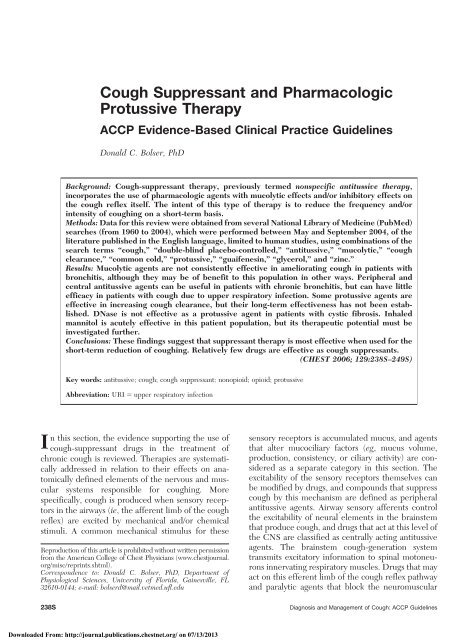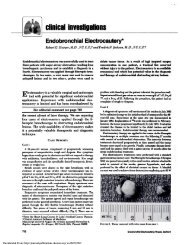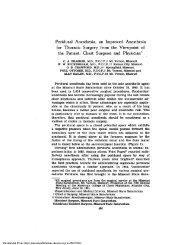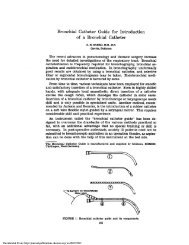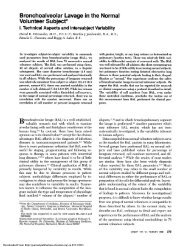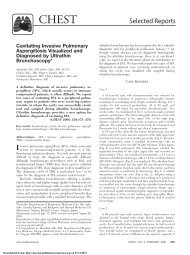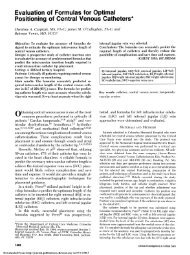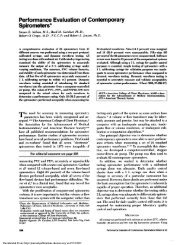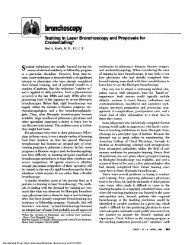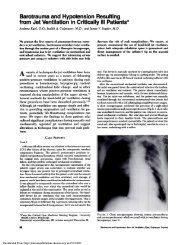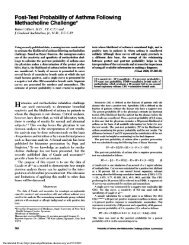Cough Suppressant and Pharmacologic Protussive Therapy - Chest ...
Cough Suppressant and Pharmacologic Protussive Therapy - Chest ...
Cough Suppressant and Pharmacologic Protussive Therapy - Chest ...
You also want an ePaper? Increase the reach of your titles
YUMPU automatically turns print PDFs into web optimized ePapers that Google loves.
<strong>Cough</strong> <strong>Suppressant</strong> <strong>and</strong> <strong>Pharmacologic</strong><br />
<strong>Protussive</strong> <strong>Therapy</strong><br />
ACCP Evidence-Based Clinical Practice Guidelines<br />
Donald C. Bolser, PhD<br />
Background: <strong>Cough</strong>-suppressant therapy, previously termed nonspecific antitussive therapy,<br />
incorporates the use of pharmacologic agents with mucolytic effects <strong>and</strong>/or inhibitory effects on<br />
the cough reflex itself. The intent of this type of therapy is to reduce the frequency <strong>and</strong>/or<br />
intensity of coughing on a short-term basis.<br />
Methods: Data for this review were obtained from several National Library of Medicine (PubMed)<br />
searches (from 1960 to 2004), which were performed between May <strong>and</strong> September 2004, of the<br />
literature published in the English language, limited to human studies, using combinations of the<br />
search terms “cough,” “double-blind placebo-controlled,” “antitussive,” “mucolytic,” “cough<br />
clearance,” “common cold,” “protussive,” “guaifenesin,” “glycerol,” <strong>and</strong> “zinc.”<br />
Results: Mucolytic agents are not consistently effective in ameliorating cough in patients with<br />
bronchitis, although they may be of benefit to this population in other ways. Peripheral <strong>and</strong><br />
central antitussive agents can be useful in patients with chronic bronchitis, but can have little<br />
efficacy in patients with cough due to upper respiratory infection. Some protussive agents are<br />
effective in increasing cough clearance, but their long-term effectiveness has not been established.<br />
DNase is not effective as a protussive agent in patients with cystic fibrosis. Inhaled<br />
mannitol is acutely effective in this patient population, but its therapeutic potential must be<br />
investigated further.<br />
Conclusions: These findings suggest that suppressant therapy is most effective when used for the<br />
short-term reduction of coughing. Relatively few drugs are effective as cough suppressants.<br />
(CHEST 2006; 129:238S–249S)<br />
Key words: antitussive; cough; cough suppressant; nonopioid; opioid; protussive<br />
Abbreviation: URI upper respiratory infection<br />
In this section, the evidence supporting the use of<br />
cough-suppressant drugs in the treatment of<br />
chronic cough is reviewed. Therapies are systematically<br />
addressed in relation to their effects on anatomically<br />
defined elements of the nervous <strong>and</strong> muscular<br />
systems responsible for coughing. More<br />
specifically, cough is produced when sensory receptors<br />
in the airways (ie, the afferent limb of the cough<br />
reflex) are excited by mechanical <strong>and</strong>/or chemical<br />
stimuli. A common mechanical stimulus for these<br />
Reproduction of this article is prohibited without written permission<br />
from the American College of <strong>Chest</strong> Physicians (www.chestjournal.<br />
org/misc/reprints.shtml).<br />
Correspondence to: Donald C. Bolser, PhD, Department of<br />
Physiological Sciences, University of Florida, Gainesville, FL<br />
32610-0144; e-mail: bolserd@mail.vetmed.ufl.edu<br />
sensory receptors is accumulated mucus, <strong>and</strong> agents<br />
that alter mucociliary factors (eg, mucus volume,<br />
production, consistency, or ciliary activity) are considered<br />
as a separate category in this section. The<br />
excitability of the sensory receptors themselves can<br />
be modified by drugs, <strong>and</strong> compounds that suppress<br />
cough by this mechanism are defined as peripheral<br />
antitussive agents. Airway sensory afferents control<br />
the excitability of neural elements in the brainstem<br />
that produce cough, <strong>and</strong> drugs that act at this level of<br />
the CNS are classified as centrally acting antitussive<br />
agents. The brainstem cough-generation system<br />
transmits excitatory information to spinal motoneurons<br />
innervating respiratory muscles. Drugs that may<br />
act on this efferent limb of the cough reflex pathway<br />
<strong>and</strong> paralytic agents that block the neuromuscular<br />
238S Diagnosis <strong>and</strong> Management of <strong>Cough</strong>: ACCP Guidelines<br />
Downloaded From: http://journal.publications.chestnet.org/ on 07/13/2013
junction are considered as separate categories in this<br />
document. Finally, the scope of this section includes<br />
those drugs that have protussive effects (ie, any drug<br />
that may increase cough clearance) in patients with<br />
disorders in which thickened or accumulated mucus<br />
contributes to morbidity.<br />
In the previous evidence-based guideline, these<br />
types of cough therapy were termed nonspecific, to<br />
differentiate them from therapy-specific for a particular<br />
disease/disorder. We have changed that terminology<br />
to suppressant therapy. Many of the drugs<br />
that fall into this category bind to specific pharmacologic<br />
receptors, <strong>and</strong> have effects on well-identified<br />
elements of the CNS <strong>and</strong> peripheral nervous systems.<br />
They are intended to reduce coughing regardless<br />
of etiology. As such, it is considered most<br />
appropriate to term them as suppressants.<br />
These types of drugs are intended to be used when<br />
the excitability <strong>and</strong>/or intensity of cough is elevated<br />
over what is required to defend the airways. Their<br />
actions presumably return a hyperresponsive cough<br />
reflex to its normal state. There is no evidence that<br />
cough-suppressant therapy can prevent coughing.<br />
An important point to note is that, unlike specific<br />
therapy, these drugs do not resolve the underlying<br />
pathophysiology that is responsible for the coughing.<br />
The classification of drugs as suppressant or nonspecific<br />
is based largely on their ability to suppress<br />
cough in animal models in which there is no underlying<br />
airway pathophysiology. Furthermore, many of<br />
these drugs decrease cough sensitivity in healthy<br />
humans who are challenged with inhaled irritants.<br />
The recommendations of the committee are restricted<br />
to the efficacy of these drugs in doubleblind,<br />
placebo-controlled studies in humans with<br />
airway pathology. While the focus of this section is<br />
on studies published since the last consensus document,<br />
other older double-blind, placebo-controlled<br />
studies that were not included in the previous report<br />
have been added. This section also refers to other<br />
studies in humans <strong>and</strong> animals in which the results<br />
shed light on mechanistic issues related to the<br />
actions of these drugs.<br />
Because of the strong track record of success of<br />
specific therapy, 1 suppressant therapies are necessary<br />
only in specific situations. In particular, their use<br />
is typically on a short-term basis for symptomatic<br />
relief of cough. As noted in our previous evidencebased<br />
guideline, 1 the use of these drugs is most<br />
appropriate when (1) the etiology of cough is unknown<br />
(precluding the use of specific therapy), (2)<br />
specific therapy requires a period of time before it<br />
can become effective, 1 or (3) specific therapy will be<br />
ineffective, such as in patients with inoperable lung<br />
cancer.<br />
Data for this review were obtained from several<br />
National Library of Medicine (PubMed) searches<br />
(from 1960 to 2004), which were performed between<br />
May <strong>and</strong> September 2004, of literature published in<br />
the English language, limited to human studies,<br />
using combinations of the search terms “cough,”<br />
“double-blind placebo controlled,” “antitussive,”<br />
“mucolytic,” “cough clearance,” “common cold,”<br />
“protussive,” “guaifenesin,” “glycerol,” <strong>and</strong> “zinc.”<br />
Drugs That Affect Mucociliary Factors<br />
This topic was not addressed separately in the<br />
previous evidence-based guideline. 1 In disorders<br />
that have associated mucus hypersecretion, cough is<br />
elicited to enhance the clearance of accumulated<br />
secretions. One pharmacologic approach to treating<br />
these disorders is to alter the mucociliary factors. As<br />
described by Irwin et al, 2 there are several mechanisms<br />
by which this may occur, as follows: (1) the<br />
drug could be an expectorant, increasing mucus<br />
volume; (2) the drug may suppress mucus production;<br />
(3) mucus consistency may be altered; <strong>and</strong> (4)<br />
ciliary function may be enhanced. These mechanisms<br />
need not be mutually exclusive. For example,<br />
it is unlikely that expectorants will alter mucus<br />
volume without also affecting its consistency. Antihistamines<br />
also may act to reduce coughing by the<br />
suppression of mucus production in URI.<br />
Relatively few drugs have been shown to suppress<br />
cough by an action on mucociliary factors, <strong>and</strong> none<br />
of them consistently. Table 1 summarizes the effects<br />
of putative mucociliary drugs on cough. Of these,<br />
inhalation of ipratropium bromide has been shown to<br />
suppress subjective measures of cough in patients<br />
with URI 3 or chronic bronchitis. 4 However, oxitropium<br />
bromide did not alter subjective measures<br />
of coughing in subjects with URI. 5 Interestingly,<br />
tiotropium does not suppress cough in patients with<br />
COPD, although cough was a outcome measure in<br />
this study. 6 It should be noted that other studies<br />
evaluating the effects of tiotropium have not measured<br />
cough. The reasons for the inconsistent effects<br />
of anticholinergic agents in disorders in which mucus<br />
production should contribute to cough are not clear.<br />
The previous guideline 1 supported the use of inhaled<br />
ipratropium bromide for cough suppression in bronchitis.<br />
The results of these more recent studies on<br />
inhaled anticholinergic agents in bronchitis have<br />
caused us to maintain a recommendation that is<br />
focused on inhaled ipratropium bromide for relief of<br />
cough due to URI or chronic bronchitis.<br />
The inconsistent actions of inhaled anticholinergic<br />
agents on cough due to URI also are relevant to the<br />
proposed mechanism of action of older, CNS penetrant,<br />
H1 antihistamines in the suppression of cough<br />
www.chestjournal.org CHEST / 129 /1/JANUARY, 2006 SUPPLEMENT 239S<br />
Downloaded From: http://journal.publications.chestnet.org/ on 07/13/2013
Drug Study/Year<br />
Guaifenesin<br />
vs placebo<br />
Guaifenesin<br />
vs placebo<br />
Guaifenesin<br />
vs placebo<br />
Guaifenesin<br />
vs placebo<br />
Iodinated<br />
glycerol<br />
vs placebo<br />
Iodinated<br />
glycerol<br />
vs placebo<br />
Iodinated<br />
glycerol<br />
vs placebo<br />
Ipratropium<br />
vs placebo<br />
Table 1—Summary of Studies on the Effects of Mucociliary Drugs on <strong>Cough</strong><br />
due to upper respiratory infection (URI). It is widely<br />
accepted that first-generation antihistamines appear<br />
to be more effective in the suppression of URIinduced<br />
cough than nonsedating H1-receptor antag-<br />
Patients,<br />
No. Age,* yr Population Dosing Results<br />
Robinson et al 9 /1977 239 Mean, 38.1 (range<br />
not reported)<br />
URI 200 mg po qid 3 d Improved cough severity<br />
<strong>and</strong> frequency<br />
(p 0.001)<br />
Kuhn et al 11 /1982 65 18–30 URI 30 mL (20 mg/mL)<br />
poq6h 2.5 d<br />
No significant effect on<br />
cough frequency <strong>and</strong><br />
severity<br />
Parvez et al10 /1996 60 18–77 Bronchiectasis, 400 mg po qid 14 d Reduction in cough intensity<br />
COPD<br />
(p 0.05)<br />
Thomson et al12 /<br />
7 642 Chronic bronchitis 600 mg po sd No effect on cough<br />
1973<br />
frequency<br />
Petty14 /1990 361 29–83 Chronic bronchitis 60 mg po qid 56 d <strong>Cough</strong> frequency <strong>and</strong><br />
severity reduced<br />
(p 0.05)<br />
Repsher13 /1993 32 Mean, 53.7 (range Chronic bronchitis 60 mg po qid 5 wk Reduction in cough severity<br />
not reported)<br />
(p 0.025)<br />
Rubin et al 15 /1996 26 Not reported Chronic bronchitis 60 mg qid 16 wk No effect on cough<br />
symptoms<br />
Ghafouri et al 4 /1984 23 27–72 Chronic bronchitis 40 g inhaled qid<br />
49 d<br />
Reduction in cough<br />
frequency <strong>and</strong> severity<br />
(p 0.05)<br />
Reduction in cough<br />
(p 0.05)<br />
No effect on cough<br />
Ipratropium<br />
vs placebo<br />
Holmes et al3 /1992 14 47 12 URI 80 g inhaled qid<br />
21 d<br />
Oxitropium<br />
vs placebo<br />
Lowry et al5 /1994 56 18–60 URI 200 g inhaled tid<br />
10 d<br />
Tiotropium<br />
vs placebo<br />
Casaburi et al6 /2000 470 65 9 COPD 18 g dry powder qd<br />
13 wk<br />
No effect on cough<br />
Bromhexine<br />
vs placebo<br />
Mossberg et al17 /<br />
1981<br />
12 39–70 Asthma, chronic<br />
bronchitis<br />
4–8 mg IV sd No effect on cough<br />
clearance<br />
Bromhexine<br />
vs placebo<br />
Olivieri et al18 /1991 88 52 15 Bronchiectasis 30 mg po tid 15 d No effect on cough<br />
symptoms; reduction in<br />
sputum volume<br />
(p 0.01)<br />
Bromhexine<br />
vs placebo<br />
Thompson <strong>and</strong><br />
Reeve19 /1972<br />
14 39–70 Chronic bronchitis,<br />
asthma, COPD<br />
16 mg bid po 21 d No effect on cough<br />
Bromhexine<br />
vs placebo<br />
Valenti <strong>and</strong><br />
Marenco20 /1989<br />
237 Bromhexine group,<br />
53 13; placebo<br />
group, 54 11<br />
COPD 30 mg po bid 14 d Significant reduction in<br />
cough (p 0.001) <strong>and</strong><br />
sputum volume<br />
(p 0.01)<br />
Carbocysteine<br />
vs placebo<br />
Edwards et al22 /<br />
1976<br />
82 35–60 Chronic bronchitis 2.25 or 3gtid10 d No significant effect on<br />
cough frequency or<br />
severity; reduction in<br />
sputum viscosity<br />
(p 0.02)<br />
Carbocysteine<br />
vs placebo<br />
Thomson et al21 /<br />
1975<br />
16 64 9 Chronic bronchitis,<br />
emphysema<br />
4gqid4–7 d No significant effect on<br />
cough frequency<br />
Acetylcysteine/<br />
isoproterenol<br />
vs placebo<br />
Hirsch et al24 /1970 12 Not reported Chronic bronchitis 10% aerosol tid 5 wk No effect on cough<br />
Acetylcysteine<br />
vs placebo<br />
Dueholm et al23 /<br />
1992<br />
65 Men, 53 2;<br />
women, 54 2<br />
Chronic bronchitis 4 mg inhaled bid<br />
16 wk<br />
Significantly greater<br />
coughing than placebo<br />
(p 0.05)<br />
Acetylcysteine<br />
vs placebo<br />
Jackson et al25 /1984 121 Mean, 63 Chronic bronchitis 200 mg po tid 12 wk No difference on cough<br />
severity<br />
Mercaptoethane<br />
sulphonate<br />
vs placebo<br />
Clarke et al26 /1979 11 63 8 Chronic bronchitis 10% aerosol tid 3 d No effect on cough<br />
frequency<br />
Mercaptoethane<br />
sulphonate/<br />
isoproterenol<br />
vs placebo<br />
Hirsch et al24 /1970 12 Not reported Chronic bronchitis 10% aerosol tid 5 wk No effect on cough<br />
Hypertonic<br />
saline<br />
vs placebo<br />
Pavia et al27 /1978 7 61 10 Chronic bronchitis 7.1% saline solution<br />
inhaled sd<br />
No effect on cough<br />
frequency<br />
*Values are given as mean SD or range, unless otherwise indicated.<br />
onists because they have greater anticholinergic activity.<br />
The therapeutic effect of cholinergic blockade<br />
by the systemic administration of sedating antihistamines<br />
is likely to be restricted to the nasal airways.<br />
240S Diagnosis <strong>and</strong> Management of <strong>Cough</strong>: ACCP Guidelines<br />
Downloaded From: http://journal.publications.chestnet.org/ on 07/13/2013
This concept is supported by the inconsistent action<br />
of inhaled anticholinergic agents on cough (ie, itis<br />
unlikely that systemically administered sedating antihistamines<br />
are acting in the lower airways). A<br />
related point is that only 7% of inhaled ipratropium<br />
bromide is systemically absorbed, <strong>and</strong> there is little<br />
evidence for the anticholinergic activity of this drug<br />
in nonpulmonary tissues when it is delivered in this<br />
manner. 7 Presumably, a systemically administered<br />
<strong>and</strong> selective anticholinergic agent would have the<br />
same efficacy on cough due to URI as the sedating<br />
antihistamine agents. However, a primary difference<br />
between first-generation <strong>and</strong> second-generation antihistamines<br />
is central penetration. It is equally plausible<br />
that first-generation antihistamines are more<br />
effective in the suppression of URI-induced cough<br />
because they act on H1 histaminergic <strong>and</strong>/or M1<br />
muscarinic receptors located in the CNS. Indeed,<br />
Muether <strong>and</strong> Gwaltney 8 have proposed this exact<br />
mechanism to explain the greater effectiveness of<br />
first-generation antihistamines over that of secondgeneration<br />
antihistamines in blocking sneezing associated<br />
with natural or induced colds. While these two<br />
potential mechanisms are not mutually exclusive, it<br />
will be a challenge to sort out their relative roles in<br />
future studies.<br />
The expectorant guaifenesin decreased subjective<br />
measures of cough due to URI, 9 <strong>and</strong> subjective <strong>and</strong><br />
objectives indexes of cough due to bronchiectasis. 10<br />
However, two other studies 11,12 found no effect of<br />
this drug on cough due to chronic bronchitis. Another<br />
expectorant, iodinated glycerol, has been<br />
found to be active in reducing subjective assessments<br />
of cough frequency <strong>and</strong> severity in patients with<br />
chronic bronchitis in two studies. 13,14 However, another<br />
study 15 found no significant benefit of iodinated<br />
glycerol on coughing in stable patients with<br />
chronic bronchitis. This drug has since been removed<br />
from the US market because of carcinogenicity<br />
concerns. 16 Bromhexine has been tested in patients<br />
with chronic bronchitis or bronchiectasis in<br />
several studies employing both subjective <strong>and</strong> objective<br />
indexes of cough. While this drug decreased<br />
sputum volume or thickness, it was inactive to<br />
modify cough in three studies 17–19 <strong>and</strong> active in only<br />
one study. 20 The latter study consisted of a much<br />
larger patient population than those in the other<br />
studies, so it is possible that the effect of bromhexine<br />
on cough is small <strong>and</strong> requires a much larger group<br />
to be detected. Carbocysteine was inactive in one<br />
study 21 to alter the clearance of secretions or cough<br />
frequency in a small population of patients with<br />
chronic bronchitis <strong>and</strong> with or without radiologic<br />
evidence of emphysema. Another larger study 22 of<br />
patients with chronic bronchitis producing at least 25<br />
mL of sputum daily showed significant reductions in<br />
objective measures of sputum viscosity after carbocysteine<br />
treatment. There were no significant<br />
changes in the subjective indexes of cough frequency<br />
or severity, but patients reported significantly better<br />
ease of expectoration while receiving therapy with<br />
carbocysteine.<br />
Other drugs such as acetylcysteine, 23–25 mercaptoethane<br />
sulfonate, 24,26 <strong>and</strong> hypertonic saline solution<br />
27 have been found to be inactive against cough<br />
in subjects with chronic bronchitis. Bromhexine,<br />
mercaptoethane sulfonate, <strong>and</strong> carbocysteine are not<br />
approved for use in the United States.<br />
In sum, these findings suggest an important conclusion<br />
regarding the actions of mucociliary agents<br />
on cough. While cough is important in the clearance<br />
of mucus from the airways, its frequency <strong>and</strong> intensity<br />
can be independent of mucus properties in<br />
patients with chronic bronchitis. It is important to<br />
note that this conclusion is specific to cough <strong>and</strong><br />
does not lessen the potential benefit of therapy with<br />
mucolytic agents in patients with chronic bronchitis<br />
on other outcomes. In essence, the data suggest that<br />
other therapeutic modalities may be more useful to<br />
manage cough in patients with chronic bronchitis.<br />
Recommendations<br />
1. In patients with chronic bronchitis, agents<br />
that have been shown to alter mucus characteristics<br />
are not recommended for cough suppression.<br />
Level of evidence, good; benefit, none; grade<br />
of recommendation, D<br />
2. In patients with cough due to URI or<br />
chronic bronchitis, the only inhaled anticholinergic<br />
agent that is recommended for cough<br />
suppression is ipratropium bromide. Level of<br />
evidence, fair; benefit, substantial; grade of recommendation,<br />
A<br />
Drugs That Affect the Afferent Limb of<br />
the <strong>Cough</strong> Reflex<br />
The classification of antitussive drugs as peripheral<br />
or central is based largely on preclinical studies.<br />
Peripherally acting suppressants lack the sedation<br />
potential that is often associated with centrally acting<br />
drugs, such as opioids, because they do not penetrate<br />
the CNS to an appreciable extent. It should be<br />
noted, however, that one centrally acting drug, dextromethorphan,<br />
is not sedating, so a central action<br />
does not guarantee sedation potential as a side-effect<br />
of cough suppression.<br />
Peripherally active drugs are thought to act wholly<br />
on the sensory elements that contribute to cough.<br />
www.chestjournal.org CHEST / 129 /1/JANUARY, 2006 SUPPLEMENT 241S<br />
Downloaded From: http://journal.publications.chestnet.org/ on 07/13/2013
While the most widely accepted mechanism of action<br />
for this class of drugs is thought to be the frank<br />
suppression of pulmonary afferent activity, 28 one<br />
prominent drug, levodropropizine, acts at least in<br />
part by the activation of C-fiber sensory afferents<br />
that reflexively inhibit cough. 29 One drug, caramiphen,<br />
has been considered as a centrally acting drug.<br />
However, according to a preclinical study, 30 this drug<br />
should be classified as a peripherally acting drug.<br />
There are apparently no other published studies on<br />
the site of action of this drug, <strong>and</strong> the US Food <strong>and</strong><br />
Drug Administration has removed this drug from the<br />
US market as an antitussive agent. 31<br />
The current review exp<strong>and</strong>s on the previous one 1<br />
for peripheral drugs by citing several more studies on<br />
levodropropizine <strong>and</strong> adding moguisteine to this list<br />
of drugs (Table 2). Levodropropizine is very active<br />
(approximately 75% suppression) in reducing cough<br />
in patients with chronic or acute bronchitis. 32 This<br />
drug also is as effective as dihydrocodeine in suppressing<br />
cough due to lung cancer, 33 although that<br />
study was not placebo-controlled. Moguisteine has<br />
been shown to be active in treating cough due to<br />
COPD. 34 This drug also can suppress cough due to<br />
URI, although the effect was restricted to cough at<br />
night <strong>and</strong> the magnitude of suppression was limited.<br />
35 Moguisteine <strong>and</strong> levodropropizine are not approved<br />
for use in the United States.<br />
<strong>Cough</strong> due to lung cancer is also sensitive to<br />
peripherally acting suppressant drugs (reviewed elsewhere<br />
in the guidelines). A placebo-controlled trial 36<br />
of inhaled sodium cromoglycate demonstrated significant<br />
suppression of cough in patients with lung<br />
cancer, presumably due to the suppression of mediator<br />
release.<br />
Recommendations<br />
3. In patients with chronic or acute bronchitis,<br />
peripheral cough suppressants, such as levo-<br />
dropropizine <strong>and</strong> moguisteine, are recommended<br />
for the short-term symptomatic relief<br />
of coughing. Level of evidence, good; benefit,<br />
substantial; grade of recommendation, A<br />
4. In patients with cough due to URI, peripheral<br />
cough suppressants have limited efficacy<br />
<strong>and</strong> are not recommended for this use. Level of<br />
evidence, good; benefit, none; grade of recommendation,<br />
D<br />
Drugs That Affect the Central<br />
Mechanism for <strong>Cough</strong><br />
This class of compounds is thought to act at one or<br />
more sites in the CNS to suppress cough. The<br />
particular CNS elements that are sensitive to these<br />
drugs are unknown. Based on preclinical experiments,<br />
37 the brainstem is thought to be the main<br />
region where antitussive agents act by a mechanism<br />
in which the motor control of cough is inhibited.<br />
However, the production of cough can be associated<br />
with sensation, termed the urge to cough, indicating<br />
that sensory information associated with cough affects<br />
suprapontine sites in the brain. 38 Furthermore,<br />
cough can be voluntarily suppressed, indicating a<br />
prominent role for cortical pathways in its control. 39<br />
It is possible that some centrally acting drugs affect<br />
the excitability of cough by interacting with suprapontine<br />
pathways that mediate sensation or the voluntary<br />
suppression of this behavior. This issue has<br />
been addressed by Hutchings <strong>and</strong> Eccles, 40 who<br />
showed that the voluntary suppression of cough was<br />
not altered by codeine or the opioid antagonist<br />
naltrexone in healthy subjects. Their work suggests<br />
that endogenous opioids do not mediate the voluntary<br />
suppression of cough. Further work is necessary<br />
to address the role of these novel mechanisms in the<br />
actions of cough suppressants in patients with airway<br />
disease.<br />
The most common patient population covered in<br />
Table 2—Summary of Studies on the Actions of Peripheral <strong>Cough</strong> <strong>Suppressant</strong>s<br />
Drug Study/Year<br />
Levodropropizine vs<br />
placebo<br />
Patients,<br />
No.<br />
Allegra <strong>and</strong> Bossi 32 /1988 194 15–79 Acute <strong>and</strong> chronic<br />
bronchitis<br />
Moguisteine vs placebo Aversa et al34 /1993 87 18–75 COPD (n 44),<br />
pulmonary neoplasm<br />
(n 7), pulmonary<br />
fibrosis (n 6),<br />
unknown (n 13),<br />
other (n 3)<br />
Age<br />
Range,<br />
yr Population Dosing Results<br />
1–10 mL po<br />
tid 3d<br />
200 mg po<br />
tid 4d<br />
Moguisteine vs placebo Adams et al 35 /1993 108 18–69 URI 200 mg po<br />
tid 3d<br />
Reduced cough severity,<br />
reduced cough frequency<br />
by 72% (p 0.05)<br />
Reduced cough frequency<br />
42% (p 0.03)<br />
Significant difference in<br />
nighttime cough severity<br />
(p 0.05)<br />
242S Diagnosis <strong>and</strong> Management of <strong>Cough</strong>: ACCP Guidelines<br />
Downloaded From: http://journal.publications.chestnet.org/ on 07/13/2013
the previous review was patients with chronic bronchitis,<br />
<strong>and</strong> a variety of centrally active drugs were<br />
deemed to be effective in patients with this disorder.<br />
Studies on patients with chronic bronchitis appear in<br />
the current review, but there also are a number of<br />
studies on patients with URI. The effects of these<br />
drugs on cough are summarized in Table 3. Pipazethate<br />
is not approved for use in the United<br />
States. The current review reveals that not all suppressant<br />
drugs are effective, especially in cough due<br />
to URI. Codeine <strong>and</strong> dextromethorphan (but not<br />
pipazethate) are active in cough due to chronic<br />
bronchitis/COPD, 41–43 suppressing cough counts by<br />
40 to 60%. However, the antitussive effects of<br />
codeine in patients with chronic bronchitis were<br />
established in small patient populations. 41–43 Furthermore,<br />
there have been no double-blind placebocontrolled<br />
studies of the effects of codeine on cough<br />
due to acute bronchitis, although it is reasonable to<br />
presume that this drug is effective under these<br />
circumstances. There have been several studies that<br />
have indicated a lack of efficacy of codeine <strong>and</strong><br />
dextromethorphan 44–47 in cough due to URI. Others<br />
10,48 have reported the suppression of cough due<br />
to URI by these drugs. As suggested by Pavesi et al, 48<br />
the reason for this discrepancy for dextromethorphan<br />
may be related to the limited efficacy ( 20%<br />
suppression) of this drug, requiring larger numbers<br />
Drug Study/Year<br />
of subjects to demonstrate a significant effect. Pavesi<br />
et al 48 conducted a metaanalysis of six separate<br />
studies of 700 subjects, while Parvez et al 10 studied<br />
300 subjects. However, it is unclear the extent<br />
to which the metaanalysis of Pavesi et al 48 overlapped<br />
with the population reported by Parvez et<br />
al. 10 The reports of Lee et al 46 <strong>and</strong> Tukiainen et al 47<br />
studied 43 <strong>and</strong> 108 subjects, respectively.<br />
The limited activity of these drugs against cough<br />
due to URI is not predictable based on our current<br />
underst<strong>and</strong>ing of the physiology <strong>and</strong> pharmacology<br />
of the cough reflex. Indeed, the fact that codeine can<br />
have a differential effect on cough based on specific<br />
pathology suggests that the central mechanisms for<br />
cough can differ significantly between disorders. In<br />
essence, cough may have the same mechanical function<br />
in different disorders, but the CNS mechanism<br />
responsible for its production may have a different<br />
neural organization, analogous to remodeling. This<br />
neural remodeling (also called plasticity) may alter<br />
the sensitivity of the central cough mechanism to<br />
various pharmacologic agents.<br />
Centrally acting opioid cough suppressants, such<br />
as hydrocodone <strong>and</strong> dihydrocodeine, have also been<br />
shown to be effective in patients with cough due to<br />
lung cancer (reviewed elsewhere in this guideline).<br />
However, the evidence for these effects was obtained<br />
from studies that were not placebo-controlled.<br />
Table 3—Summary of Studies on the Actions of Central <strong>Cough</strong> <strong>Suppressant</strong>s*<br />
Patients,<br />
No. Age† Population Dosing Results<br />
Codeine vs placebo Aylward et al41 /1984 8 54–65 Chronic bronchitis 7.5–30 mg po 1 d sd Reduced cough counts by 40% at 30<br />
mg (p 0.05), no effect of lower<br />
doses<br />
Codeine vs placebo Freestone <strong>and</strong><br />
Eccles 44 /1997<br />
82 18–46 URI, LRI 50 mg po qd 2 d No difference in cough frequency,<br />
severity, or cough sound pressure<br />
differences<br />
10 65 7 Chronic bronchitis 30 mg po tid 1 d <strong>Cough</strong> frequency reduced 47%<br />
(p 0.01)<br />
Codeine vs placebo Sevelius <strong>and</strong><br />
Colmore42 /1966<br />
Codeine vs placebo Sevelius et al43 /1971 12 55–72 COPD 7.5–60 mg po 1 d Reduced cough counts by 60%<br />
(p 0.004)<br />
Dextromethorphan<br />
vs placebo<br />
Lee et al46 /2000 43 18–46 URI 30 mg po 1 d No difference in cough frequency,<br />
severity, or cough sound pressure<br />
differences<br />
Dextromethorphan<br />
vs placebo<br />
Pavesi et al48 /2001 710 18–69 URI 30 mg po 1 d <strong>Cough</strong> frequency significantly<br />
reduced at 1h(p0.003), cough<br />
intensity not reduced<br />
Dextromethorphan<br />
vs placebo<br />
Tukainen et al47 /<br />
1986<br />
108 Mean, 38 (range<br />
not reported)<br />
URI 30 mg po tid 4 d No significant difference in cough<br />
frequency or severity<br />
Dextromethorphan<br />
vs placebo<br />
Aylward et al41 /1984 8 54–65 Chronic bronchitis 7.5–60 mg po 1 d sd Reduced cough counts by 50% at 60<br />
mg (p 0.05), 28% at 30 mg, no<br />
effect of 7.5 <strong>and</strong> 15 mg<br />
Dextromethorphan<br />
vs placebo<br />
Korppi et al45 /1991 78 1–10 RI 7.5 or 15 mg in 5 or 10<br />
mL tid 3d<br />
No significant difference in cough<br />
frequency or severity<br />
Dextromethorphan<br />
vs placebo<br />
Parvez et al10 /1996 451 18–69 URI 30 mg po 1 d sd Reduction in cough counts 19–36%<br />
(p 0.05), reduction in cough<br />
effort 41% (p 0.05)<br />
Pipazethate vs<br />
placebo<br />
Sevelius <strong>and</strong><br />
Colmore42 /1966<br />
10 65 7 Chronic bronchitis 5 mL po 1 d No significant difference in cough<br />
frequency<br />
*LR lower respiratory tract infection; RI respiratory infection.<br />
†Values are given as range or mean SD, unless otherwise indicated.<br />
www.chestjournal.org CHEST / 129 /1/JANUARY, 2006 SUPPLEMENT 243S<br />
Downloaded From: http://journal.publications.chestnet.org/ on 07/13/2013
Recommendations<br />
5. In patients with chronic bronchitis, central<br />
cough suppressants, such as codeine <strong>and</strong> dextromethorphan,<br />
are recommended for the<br />
short-term symptomatic relief of coughing.<br />
Level of evidence, fair; benefit, intermediate; grade<br />
of recommendation, B<br />
6. In patients with cough due to URI, central<br />
cough suppressants have limited efficacy<br />
for symptomatic relief <strong>and</strong> are not recommended<br />
for this use. Level of evidence, good;<br />
benefit, none; grade of recommendation, D<br />
Drugs That Affect the Efferent Limb of<br />
<strong>Cough</strong> Reflex<br />
In this context, the efferent limb of the cough<br />
reflex is defined as a spinal action of the drug. While<br />
this definition appears to overlap with that of centrally<br />
acting drugs, it bears specific attention here. As<br />
defined above, our current definition of centrally<br />
acting antitussive drugs is restricted to those acting<br />
in the brainstem <strong>and</strong>/or at suprapontine sites. A drug<br />
that selectively suppressed the excitability of spinal<br />
pathways to abdominal muscle motoneurons would<br />
be expected to ameliorate intense expiratory efforts<br />
associated with repetitive coughing <strong>and</strong> would represent<br />
a useful adjunct to existing specific therapies.<br />
Of the drugs known to have central actions to inhibit<br />
cough, baclofen may be an example of a drug with<br />
this mechanism of action. It is well-known that this<br />
drug is a muscle relaxant with a spinal action. 49<br />
Baclofen is a centrally acting cough suppressant in<br />
animals 50 <strong>and</strong> suppresses irritant-induced cough in<br />
humans. 51,52 Furthermore, this drug did suppress<br />
subjective measures of angiotensin-converting enzyme<br />
inhibitor-induced cough in an open-label<br />
study. 53 However, this drug has not yet been tested<br />
for activity in double-blind placebo-controlled studies<br />
of pathologic cough. The utility of this drug or<br />
others that may have solely a spinal action in the<br />
treatment of cough due to airway disease awaits<br />
further study.<br />
Recommendation<br />
7. In patients with chronic or acute cough<br />
requiring symptomatic relief, drugs that affect<br />
the efferent limb of the cough reflex are not<br />
recommended. Level of evidence, low; benefit, none;<br />
grade of recommendation, D<br />
Drugs That Affect the Skeletal Muscles<br />
Neuromuscular blocking agents have been used in<br />
conjunction with anesthetics to suppress cough <strong>and</strong><br />
thus to facilitate intubation. The depolarizing agent,<br />
succinylcholine, is most commonly used for this<br />
application but has a significant side effect profile. 54<br />
Newer non-depolarizing agents have fewer side effects<br />
but do not possess the rapid onset <strong>and</strong> recovery<br />
associated with succinylcholine. 54–56 Erhan et al, 56 in<br />
a double-blind study, showed that anesthetics, especially<br />
propofol, can provide adequate cough suppression<br />
for intubation in the absence of neuromuscular<br />
blockade. However, a single-blind study 57 found<br />
treatment with a neuromuscular blocker (atracurium)<br />
plus propofol to be more effective than<br />
propofol alone in suppressing cough induced by<br />
intubation. The increased efficacy of neuromuscular<br />
blocking agents in combination with anesthetics in<br />
suppressing cough accounts for their use during<br />
intubation.<br />
Recommendation<br />
8. In patients requiring intubation during<br />
general anesthesia, the use of neuromuscular<br />
blocking agents is recommended to suppress<br />
coughing. Level of evidence, good; benefit, substantial;<br />
grade of recommendation, A<br />
Other Drugs<br />
Table 4 summarizes studies on the effects of zinc<br />
acetate or zinc gluconate on the common cold, 58–66<br />
<strong>and</strong> two studies 63,67 evaluated cough with subjective<br />
measures. Mixed results were obtained, with some<br />
studies 58,59,61,63,67 indicating a positive effect of zinc<br />
preparations on the common cold <strong>and</strong> others<br />
60,62,64–66 suggesting no benefit. Two metaanalyses<br />
68,69 of these studies have been performed, <strong>and</strong><br />
both concluded that there was insufficient evidence<br />
to support the use of zinc preparations in the<br />
treatment of the common cold. Various explanations<br />
for the divergent results of these studies have been<br />
proposed including widely variant dosages, inadequate<br />
blinding, <strong>and</strong> bioavailability issues. 70 Furthermore,<br />
zinc therapy can be associated with a significant<br />
side-effect profile, in particular bad taste <strong>and</strong><br />
nausea. 70 Of these two preparations, only zinc acetate<br />
is approved for use in the United States.<br />
Albuterol has been evaluated in two studies of<br />
acute (ie, 4 weeks) cough 71,72 (Table 4). <strong>Cough</strong><br />
was evaluated by subjective measurements in both<br />
studies. Bernard et al 71 studied nonasthmatic children<br />
in whom the exact cause of cough was not<br />
determined, but cough resolved within 7 days in<br />
both the placebo <strong>and</strong> treatment groups. Littenberg<br />
et al 72 studied adults with either bronchitis or cough<br />
244S Diagnosis <strong>and</strong> Management of <strong>Cough</strong>: ACCP Guidelines<br />
Downloaded From: http://journal.publications.chestnet.org/ on 07/13/2013
of undetermined origin. Albuterol had no significant<br />
effect on coughing in either study.<br />
Over the counter, non-prescription medications<br />
are commonly used to treat acute cough <strong>and</strong> other<br />
symptoms associated with the common cold. The<br />
combination medications contain antitussives, expectorants,<br />
sympathomimetics, <strong>and</strong>/or antihistamines;<br />
many are carried in a demulcent vehicle. Unfortunately,<br />
with the exception of an older antihistaminedecongestant<br />
combination, 73 many have never been<br />
shown to be effective, many have never been studied<br />
in combination, <strong>and</strong> some drugs in the combination<br />
products are indicated only for other conditions.<br />
Fortunately, one is not limited to having to take one<br />
of these combination medications because there are<br />
available effective cough suppressant medications<br />
that work in a variety of different ways. For further<br />
information, readers are encouraged to refer to<br />
section on <strong>Cough</strong> <strong>and</strong> the Common Cold in this<br />
guideline.<br />
Recommendations<br />
9. In patients with acute cough due to the<br />
common cold, preparations containing zinc are<br />
Table 4—Influence of Other Drugs on <strong>Cough</strong><br />
Drug Study/Year Patients, No. Age,* yr Population Dosing Results<br />
Zinc acetate vs<br />
placebo<br />
Zinc gluconate vs<br />
placebo<br />
Zinc gluconate vs<br />
placebo<br />
Zinc gluconate vs<br />
placebo<br />
Zinc gluconate vs<br />
placebo<br />
Zinc gluconate vs<br />
placebo<br />
Zinc gluconate vs<br />
placebo<br />
Zinc gluconate vs<br />
placebo<br />
Prasad et al67 /2000 50 37 11 Common cold 42.96 mg po q2–3 h<br />
during the day<br />
Mossad et al63 /1996 100 38 8 Common cold 13.3 mg po q2 h during<br />
the day<br />
Eby et al59 /1984 65 11–63 Common cold 46 mg po loading dose,<br />
then q2 h while<br />
awake for maximum<br />
9d<br />
Smith et al64 /1989 110 18 Common cold 23 mg po q2 h while<br />
awake for 7 d<br />
Godfrey et al61 /1992 73 18–40 Common cold 23.7 mg po q2 h while<br />
awake for 7 d<br />
Weismann et al66 / 130 18–65 Common cold 4.5 mg po q1.5 h for<br />
1990<br />
10 d<br />
Al-Nakib et al58 / 12 18–50 Rhinovirus-induced 23 mg po q2 h while<br />
1987<br />
cold<br />
awake for 6 d<br />
Farr et al 60 /1987 32 (part 1);<br />
45 (part 2)<br />
21 1 Rhinovirus-induced<br />
cold<br />
23 mg po q2 h while<br />
awake for 5dinpart<br />
1<strong>and</strong>8dinpart2<br />
Reduction in duration of coughing<br />
by3d(p0.001) Reduction in duration of coughing<br />
by 2.5 d (p 0.04)<br />
Higher percent of subject<br />
asymptomatic after 7 d<br />
(p 0.0005)<br />
No effect on duration of symptoms,<br />
8% reduction in symptom severity<br />
(p 0.02)<br />
Significantly shorter duration of<br />
symptoms (p 0.025)<br />
No effect on symptom duration or<br />
severity<br />
Reduction in clinical symptom score<br />
on days 4 <strong>and</strong> 5 postchallenge<br />
(p 0.05)<br />
No effect on severity or duration of<br />
symptoms<br />
Zinc gluconate vs<br />
placebo<br />
Macknin et al62 /<br />
1998<br />
249 6–16 Common cold 10 mg po q2–3 h while<br />
awake for 2 d<br />
No effect on duration of symptoms<br />
Zinc gluconate, zinc<br />
acetate vs<br />
placebo<br />
Turner <strong>and</strong><br />
Cetnarowski65 /<br />
2000<br />
273 (part 1);<br />
281 (part 2)<br />
18–65 Rhinovirus induced<br />
(part 1); common<br />
cold (part 2)<br />
5or11.5mgzinc<br />
acetate, 13.3 zinc<br />
gluconate q2–3 h<br />
while awake for 14 d<br />
Significantly shorter duration of<br />
symptoms by zinc gluconate in<br />
part 1 (p 0.035), no effect in<br />
part 2 of either formulation<br />
Albuterol vs placebo Bernard et al71 /1999 59 1–10 Nonasthmatic,<br />
otherwise<br />
undetermined<br />
0.1 mg/kg po tid 7 d No effect on cough<br />
Albuterol vs placebo Littenberg et al72 / 104 19–74 Nonasthmatic, 4mgpotid7d No difference in cough severity<br />
1996<br />
nonpneumonia,<br />
non-COPD,<br />
otherwise<br />
undetermined<br />
*Values are given as the mean SD or range.<br />
not recommended. Level of evidence, good; benefit,<br />
none; grade of recommendation, D<br />
10. In patients with acute cough due to the<br />
common cold, over the counter combination<br />
cold medications, with the exception of an older<br />
antihistamine-decongestant, are not recommended<br />
until r<strong>and</strong>omized controlled trials<br />
prove that they are effective cough suppressants.<br />
Level of evidence, fair; benefit, none; grade of<br />
recommendation, D<br />
11. In patients with acute or chronic cough<br />
not due to asthma, albuterol is not recommended.<br />
Level of evidence, good; benefit, none;<br />
grade of recommendation, D<br />
<strong>Pharmacologic</strong> <strong>Protussive</strong> <strong>Therapy</strong><br />
<strong>Protussive</strong> therapy is intended to enhance cough<br />
effectiveness to promote the clearance of airway<br />
secretions. The most common disorders in which this<br />
type of therapy is indicated include cystic fibrosis,<br />
bronchiectasis, pneumonia, <strong>and</strong> postoperative atelectasis.<br />
2 In these disorders, mechanical methods to<br />
loosen mucus or pharmacologic tools that increase<br />
cough clearance may be useful to increase the<br />
www.chestjournal.org CHEST / 129 /1/JANUARY, 2006 SUPPLEMENT 245S<br />
Downloaded From: http://journal.publications.chestnet.org/ on 07/13/2013
effectiveness of coughing. Mechanical protussive<br />
procedures are covered in another section of this<br />
guideline. These approaches require the cough motor<br />
control system to be competent. It should be<br />
noted that there are several prominent disorders in<br />
which cough is impaired <strong>and</strong> the resultant accumulation<br />
of secretions contributes significantly to morbidity.<br />
<strong>Cough</strong> can be impaired after stroke or spinal<br />
injury. The impairment of cough after stroke can<br />
contribute to aspiration, <strong>and</strong> this topic has been<br />
reviewed elsewhere in this guideline. Therapeutic<br />
approaches to the impairment of cough after spinal<br />
injury have been restricted to mechanical methodologies<br />
intended to harvest accumulated secretions<br />
(eg, suctioning of the airway in tracheostomized<br />
patients) or to enhance cough airflows. 74 There are<br />
currently no pharmacologic therapies for the enhancement<br />
of cough in disorders in which the motor<br />
system for this behavior is impaired.<br />
Recommendation<br />
12. In patients with neuromuscular impairment,<br />
protussive pharmacologic agents are ineffective<br />
<strong>and</strong> should not be prescribed. Level of<br />
evidence, good; benefit, none; grade of recommendation,<br />
D<br />
<strong>Pharmacologic</strong> Enhancement of <strong>Cough</strong><br />
Clearance<br />
The previous evidence-based guideline 1 cited r<strong>and</strong>omized,<br />
double-blind, placebo-controlled studies<br />
showing that hypertonic saline solution <strong>and</strong> erdosteine<br />
(which is not approved for use in the United<br />
States) were effective agents for increasing cough<br />
clearance in patients with bronchitis, <strong>and</strong> that amiloride<br />
was effective for this function in patients with<br />
cystic fibrosis. Ineffective agents (in bronchitic patients)<br />
included carbocysteine, mercaptoethane sulfonate,<br />
bromhexine, <strong>and</strong> guaifenesin. Terbutaline<br />
Drug Study/Year<br />
was also shown to be effective in combination with<br />
chest physiotherapy <strong>and</strong> postural drainage in patients<br />
with bronchiectasis.<br />
The current guideline includes two new studies<br />
that investigated the effects of recombinant DNase<br />
on cough clearance 75 <strong>and</strong> mucociliary clearance 76 in<br />
subjects with cystic fibrosis (Table 5). Both studies<br />
also recorded subjective measures of spontaneous<br />
cough. Neither study demonstrated a significant<br />
action of recombinant DNase over placebo, although<br />
Robinson et al 75 suggested that their study may have<br />
been underpowered given the large intersubject<br />
variability that they encountered.<br />
A double-blind placebo-controlled study 77 showed<br />
that the inhalation of dry-powder mannitol increased<br />
cough clearance in patients with cystic fibrosis (Table<br />
5). In this study, mannitol was as effective as<br />
hypertonic saline solution in increasing mucociliary<br />
clearance. The long-term effectiveness <strong>and</strong> safety of<br />
mannitol must be confirmed before it should be<br />
considered as a treatment for cystic fibrosis patients.<br />
Recommendations<br />
13. In patients with bronchitis, hypertonic<br />
saline solution <strong>and</strong> erdosteine are recommended<br />
on a short-term basis to increase cough<br />
clearance. Level of evidence, good; benefit, substantial;<br />
grade of recommendation, A<br />
14. In adult patients with cystic fibrosis,<br />
amiloride is recommended to increase cough<br />
clearance. Level of evidence, good; benefit, substantial;<br />
grade of recommendation, A<br />
15. In adult patients with cystic fibrosis,<br />
while recombinant DNase does improve spirometry<br />
it is not recommended to increase<br />
cough clearance. Level of evidence, good; benefit,<br />
none; grade of recommendation, D<br />
Conclusions<br />
Relatively few drugs are effective for the nonspecific<br />
suppression of cough. Our current recommen-<br />
Table 5—Influence of <strong>Protussive</strong> Drugs on <strong>Cough</strong> or <strong>Cough</strong> Clearance<br />
Patients,<br />
No. Age,* yr Population Dosing Results<br />
DNase vs placebo Laube et al75 /1996 20 18–44 Cystic fibrosis 2.5 mg inhaled bid 6 d No effect on cough<br />
frequency<br />
DNase vs placebo Robinson et al74 /2000 13 25 5 Cystic fibrosis 2.5 mg inhaled qd 7 d No effect on cough<br />
clearance<br />
Mannitol vs placebo Robinson et al76 /1999 12 30 9 Cystic fibrosis 300 mg dry powder sd Increase in cough<br />
clearance (p 0.01)<br />
*Values are given as the range or mean SD.<br />
246S Diagnosis <strong>and</strong> Management of <strong>Cough</strong>: ACCP Guidelines<br />
Downloaded From: http://journal.publications.chestnet.org/ on 07/13/2013
dations largely confirm <strong>and</strong> extend the findings of<br />
the previous panel. 1 Most notably, the current guidelines<br />
exp<strong>and</strong> on the previous consensus by recommending<br />
that the use of suppressants be guided by<br />
the physician’s specific knowledge of the disorder<br />
that is eliciting cough.<br />
The previous guideline 1 identified a number of<br />
different drugs as effective cough suppressants, particularly<br />
in patients with chronic bronchitis. These<br />
drugs included codeine, dextromethorphan, ipratropium<br />
bromide, <strong>and</strong> diphenhydramine. The previous<br />
guideline also included the following several drugs<br />
that are not available in the United States: caramiphen;<br />
levodropropizine; the acetylsalicylic acid prodrug<br />
guaimesal; the phosphodiesterase inhibitor <strong>and</strong><br />
antidopaminergic agent glaucine; <strong>and</strong> the analgesic<br />
viminol. The current recommendations have been<br />
revised to narrow recommended inhaled anticholinergic<br />
agents to a single drug, ipratropium bromide,<br />
for cough due to URI or bronchitis. The current<br />
guideline supports the use of codeine only in chronic<br />
bronchitis <strong>and</strong> not in cough due to URI. The previous<br />
guideline also recommended naproxen <strong>and</strong> dexbrompheniramine/pseudoephedrine<br />
for cough due<br />
to colds.<br />
<strong>Protussive</strong> agents that were recommended previously<br />
were relatively few in number, <strong>and</strong> the present<br />
guideline is essentially unchanged in this regard,<br />
with the exception that recommendations regarding<br />
cystic fibrosis have been limited to adult patients.<br />
See Chang <strong>and</strong> Glomb (these guidelines) 78 on evaluating<br />
cough in pediatric patients for specific recommendations<br />
regarding that group.<br />
Summary of Recommendations<br />
1. In patients with chronic bronchitis,<br />
agents that have been shown to alter mucus<br />
characteristics are not recommended for<br />
cough suppression. Level of evidence, good;<br />
benefit, none; grade of recommendation, D<br />
2. In patients with cough due to URI or<br />
chronic bronchitis, the only inhaled anticholinergic<br />
agent that is recommended for<br />
cough suppression is ipratropium bromide.<br />
Level of evidence, fair; benefit, substantial;<br />
grade of recommendation, A<br />
3. In patients with chronic or acute bronchitis,<br />
peripheral cough suppressants, such<br />
as levodropropizine <strong>and</strong> moguisteine, are<br />
recommended for the short-term symptomatic<br />
relief of coughing. Level of evidence,<br />
good; benefit, substantial; grade of recommendation,<br />
A<br />
4. In patients with cough due to URI,<br />
peripheral cough suppressants have limited<br />
efficacy <strong>and</strong> are not recommended for this<br />
use. Level of evidence, good; benefit, none;<br />
grade of recommendation, D<br />
5. In patients with chronic bronchitis,<br />
central cough suppressants, such as codeine<br />
<strong>and</strong> dextromethorphan, are recommended<br />
for the short-term symptomatic relief of<br />
coughing. Level of evidence, fair; benefit, intermediate;<br />
grade of recommendation, B<br />
6. In patients with cough due to URI, central<br />
cough suppressants have limited efficacy<br />
for symptomatic relief <strong>and</strong> are not recommended<br />
for this use. Level of evidence, good;<br />
benefit, none; grade of recommendation, D<br />
7. In patients with chronic or acute cough<br />
requiring symptomatic relief, drugs that affect<br />
the efferent limb of the cough reflex<br />
are not recommended. Level of evidence, low;<br />
benefit, none; grade of recommendation, D<br />
8. In patients requiring intubation during<br />
general anesthesia, the use of neuromuscular<br />
blocking agents is recommended to suppress<br />
coughing. Level of evidence, good; benefit,<br />
substantial; grade of recommendation, A<br />
9. In patients with acute cough due to the<br />
common cold, preparations containing zinc<br />
are not recommended. Level of evidence,<br />
good; benefit, none; grade of recommendation,<br />
D<br />
10. In patients with acute cough due to<br />
the common cold, over the counter combination<br />
cold medications, with the exception<br />
of an older antihistamine-decongestant,<br />
are not recommended until<br />
r<strong>and</strong>omized controlled trials prove that<br />
they are effective cough suppressants.<br />
Level of evidence, fair; benefit, none; grade of<br />
reccommendation: D<br />
11. In patients with acute or chronic<br />
cough not due to asthma, albuterol is not<br />
recommended. Level of evidence, good; benefit,<br />
none; grade of recommendation, D<br />
12. In patients with neuromuscular impairment,<br />
protussive pharmacologic agents<br />
are ineffective <strong>and</strong> should not be prescribed.<br />
Level of evidence, good; benefit, none;<br />
grade of recommendation, D<br />
13. In patients with bronchitis, hypertonic<br />
saline solution <strong>and</strong> erdosteine are recommended<br />
on a short-term basis to increase<br />
cough clearance. Level of evidence, good;<br />
benefit, substantial; grade of recommendation, A<br />
www.chestjournal.org CHEST / 129 /1/JANUARY, 2006 SUPPLEMENT 247S<br />
Downloaded From: http://journal.publications.chestnet.org/ on 07/13/2013
14. In adult patients with cystic fibrosis,<br />
amiloride is recommended to increase<br />
cough clearance. Level of evidence, good;<br />
benefit, substantial; grade of recommendation, A<br />
15. In adult patients with cystic fibrosis,<br />
while recombinant DNase does improve spirometry<br />
it is not recommended to increase<br />
cough clearance. Level of evidence, good; benefit,<br />
none; grade of recommendation, D<br />
References<br />
1 Irwin RS, Boulet LP, Cloutier MM, et al. Managing cough as<br />
a defense mechanism <strong>and</strong> as a symptom: a consensus panel<br />
report of the American College of <strong>Chest</strong> Physicians. <strong>Chest</strong><br />
1998; 114(suppl):133S–181S<br />
2 Irwin RS, Curley FJ, Bennett FM. Appropriate use of<br />
antitussives <strong>and</strong> protussives: a practical review. Drugs 1993;<br />
46:80–91<br />
3 Holmes PW, Barter CE, Pierce RJ. Chronic persistent cough:<br />
use of ipratropium bromide in undiagnosed cases following<br />
upper respiratory tract infection. Respir Med 1992; 86:425–429<br />
4 Ghafouri MA, Patil KD, Kass I. Sputum changes associated<br />
with the use of ipratropium bromide. <strong>Chest</strong> 1984; 86:387–393<br />
5 Lowry R, Wood A, Higenbottam T. The effect of anticholinergic<br />
bronchodilator therapy on cough during upper respiratory<br />
tract infections. Br J Clin Pharmacol 1994; 37:187–191<br />
6 Casaburi R, Briggs DD, Donohue JF, et al. The spirometric<br />
efficacy of once-daily dosing with tiotropium in stable COPD.<br />
<strong>Chest</strong> 2000; 118:1294–1302<br />
7 Ensing K, de Zeeuw RA, Nossent GD, et al. Pharmacokinetics<br />
of ipratropium bromide after single dose inhalation <strong>and</strong><br />
oral <strong>and</strong> intravenous administration. Eur J Clin Pharmacol<br />
1989; 36:189–194<br />
8 Muether PS, Gwaltney JM Jr. Variant effect of first- <strong>and</strong><br />
second-generation antihistamines as clues to their mechanism<br />
of action on the sneeze reflex in the common cold. Clin Infect<br />
Dis 2001; 33:1483–1488<br />
9 Robinson R, Cummings WB, Deffenbaugh ER. Effectiveness<br />
of guaifenesin as an expectorant: a cooperative double-blind<br />
study. Curr Ther Res 1977; 22:284–296<br />
10 Parvez L, Vaidya M, Sakhard<strong>and</strong>e A, et al. Evaluation of<br />
antitussive agents in man. Pulm Pharmacol 1996; 9:299–308<br />
11 Kuhn JJ, Hendley JO, Adams KF, et al. Antitussive effect of<br />
guaifenesin in young adults with natural colds: objective <strong>and</strong><br />
subjective assessment. <strong>Chest</strong> 1982; 82:713–718<br />
12 Thomson ML, Pavia D, McNicol MW. A preliminary study of<br />
the effect of guaiphenesin on mucociliary clearance from the<br />
human lung. Thorax 1973; 28:742–747<br />
13 Repsher LH. Treatment of stable chronic bronchitis with<br />
iodinated glycerol: a double-blind, placebo-controlled trial.<br />
J Clin Pharmacol 1993; 33:856–860<br />
14 Petty TL. The National Mucolytic Study: results of a r<strong>and</strong>omized,<br />
double-blind, placebo-controlled study of iodinated glycerol<br />
in chronic obstructive bronchitis. <strong>Chest</strong> 1990; 97:75–83<br />
15 Rubin BK, Ramirez O, Ohar JA. Iodinated glycerol has no<br />
effect on pulmonary function, symptom score, or sputum<br />
properties in patients with stable chronic bronchitis. <strong>Chest</strong><br />
1996; 109:348–352<br />
16 Drug products withdrawn or removed from the market for<br />
reasons of safety or effectiveness. Federal Register March 8<br />
1999; 64:10947<br />
17 Mossberg B, Philipson K, Str<strong>and</strong>berg K, et al. Clearance by<br />
voluntary coughing <strong>and</strong> its relationship to subjective assessment<br />
<strong>and</strong> effect of intravenous bromhexine. Eur J Respir Dis<br />
1981; 62:173–179<br />
18 Olivieri D, Ciaccia A, Marangio E, et al. Role of bromhexine<br />
in exacerbations of bronchiectasis: double-blind r<strong>and</strong>omized<br />
multicenter study versus placebo. Respiration 1991; 58:117–<br />
121<br />
19 Thompson KJ, Reeve J. A clinical trial of bromhexine. N Z<br />
Med J 1972; 76:73–76<br />
20 Valenti S, Marenco G. Italian multicenter study on the<br />
treatment of chronic obstructive lung disease with bromhexine:<br />
a double-blind placebo-controlled trial. Respiration 1989;<br />
56:11–15<br />
21 Thomson ML, Pavia D, Jones CJ, et al. No demonstrable<br />
effect of S-carboxymethylcysteine on clearance of secretions<br />
from the human lung. Thorax 1975; 30:669–673<br />
22 Edwards G, Steel AE, Scott JK, et al. S-Carboxymethylcysteine<br />
in the fluidification of sputum <strong>and</strong> treatment of chronic<br />
airway obstruction. <strong>Chest</strong> 1976; 70:506–513<br />
23 Dueholm M, Neilsen C, Thorshauge H, et al. N-acetylcysteine<br />
by metered dose inhaler in the treatment of chronic<br />
bronchitis: a multi-centre study. Respir Med 1992; 86:89–92<br />
24 Hirsch SR, Viernes PF, Kory RC. Clinical <strong>and</strong> physiological<br />
evaluation of mucolytic agents nebulized with soproterenol:<br />
10 per cent N-acetylcysteine verus 10 per cent 2-mercaptoethane<br />
sulphonate. Thorax 1970; 25:737–743<br />
25 Jackson IM, Barnes J, Cooksey P. Efficacy <strong>and</strong> tolerability of oral<br />
acetylcysteine (Fabrol) in chronic bronchitis: a double-blind<br />
placebo controlled study. J Int Med Res 1984; 12:198–206<br />
26 Clarke S, Lopez-Vidriero MT, Pavia D, et al. The effect of<br />
sodium 2-mercaptoethane sulphonate <strong>and</strong> hypertonic saline<br />
aerosols on bronchial clearance in chronic bronchitis. Br J<br />
Clin Pharmacol 1979; 7:39–44<br />
27 Pavia D, Thomson ML, Clarke SW. Enhanced clearance of secretions<br />
from the human lung after the administration of hypertonic<br />
saline aerosol. Am Rev Respir Dis 1978; 117:199–203<br />
28 Shams H, Daffonchio L, Scheid P. Effects of levodropropizine<br />
on vagal afferent C-fibres in the cat. Br J Pharmacol<br />
1996; 117:853–858<br />
29 Lavezzo A, Melillo G, Clavenna G, et al. Peripheral site of<br />
action of levodropropizine in experimentally-induced cough:<br />
role of sensory neuropeptides. Pulm Pharmacol 1992; 5:143–<br />
147<br />
30 Bolser D, DeGennaro FC, Chapman RW, et al. Central <strong>and</strong><br />
peripheral sites of action of antitussive drugs in the cat. In:<br />
Trouth C, Millis RM, eds. Ventral brainstem mechanisms <strong>and</strong><br />
control of respiration <strong>and</strong> blood pressure. New York, NY:<br />
Marcel Dekker, 1995; 95–102<br />
31 Oral prescription drugs offered for relief of symptoms of<br />
cough, cold, or allergy; drug efficacy study implementation;<br />
caramiphen edisylate; final actions on supplemental new drug<br />
applications. Federal Register June 28 2000; 65:42017<br />
32 Allegra L, Bossi R. Clinical trials with the new antitussive<br />
levodropizine in adult bronchitic patients. Drug Res 1988;<br />
38:1163–1166<br />
33 Luporini G, Barni S, Marchi E, et al. Efficacy <strong>and</strong> safety of<br />
levodropropizine <strong>and</strong> dihydrocodeine on nonproductive<br />
cough in primary <strong>and</strong> metastatic lung cancer. Eur Respir J<br />
1998; 12:97–101<br />
34 Aversa A, Cazzola M, Clini V, et al. Clinical trial of the<br />
efficacy <strong>and</strong> safety of moguisteine in patients with cough<br />
associated with chronic respiratory diseases. Drugs Exp Clin<br />
Res 1993; 19:273–279<br />
35 Adams R, Hosie J, James I, et al. Antitussive activity <strong>and</strong><br />
tolerability of moguisteine in patients with acute cough: a<br />
248S Diagnosis <strong>and</strong> Management of <strong>Cough</strong>: ACCP Guidelines<br />
Downloaded From: http://journal.publications.chestnet.org/ on 07/13/2013
<strong>and</strong>omized double-blind placebo-controlled study. Adv Ther<br />
1993; 10:263–271<br />
36 Moroni M, Porta C, Gualtieri G, et al. Inhaled sodium<br />
cromoglycate to treat cough in advanced lung cancer patients.<br />
Br J Cancer 1996; 74:309–311<br />
37 Chou D, Wang SC. Studies on the localization of the central<br />
cough mechanism: site of action of antitussive drugs. J Pharmacol<br />
Exp Ther 1975; 194:499–505<br />
38 Davenport P, Sapienza CM, Bolser DC. Psychophysical<br />
assessment of the urge-to-cough. Eur Respir Rev 2002;<br />
85:249–253<br />
39 Hutchings HA, Eccles R, Smith AP, et al. Voluntary cough<br />
suppression as an indication of symptom severity in upper<br />
respiratory tract infections. Eur Respir J 1993; 6:1449–1454<br />
40 Hutchings HA, Eccles R. The opioid agonist codeine <strong>and</strong><br />
antagonist naltrexone do not affect voluntary suppression of<br />
capsaicin induced cough in healthy subjects. Eur Respir J<br />
1994; 7:715–719<br />
41 Aylward M, Maddock J, Davies DE, et al. Dextromethorphan<br />
<strong>and</strong> codeine: comparison of plasma kinetics <strong>and</strong> antitussive<br />
effects. Eur J Respir Dis 1984; 65:283–291<br />
42 Sevelius H, Colmore JP. Objective assessment of antitussive<br />
agents in patients with chronic cough. J New Drugs 1966;<br />
6:216–223<br />
43 Sevelius H, McCoy JF, Colmore JP. Dose response to<br />
codeine in patients with chronic cough. Clin Pharmacol Ther<br />
1971; 12:449–455<br />
44 Freestone C, Eccles R. Assessment of the antitussive efficacy<br />
of codeine in cough associated with common cold. J Pharm<br />
Pharmacol 1997; 49:1045–1049<br />
45 Korppi M, Laurikainen K, Pietikainen M, et al. Antitussives in<br />
the treatment of acute transient cough in children. Acta<br />
Paediatr Sc<strong>and</strong> 1991; 80:969–971<br />
46 Lee PCL, Jawad MS, Eccles R. Antitussive efficacy of dextromethorphan<br />
in cough associated with acute upper respiratory<br />
tract infection. J Pharm Pharmacol 2000; 52:1137–1142<br />
47 Tukiainen H, Karttunen P, Silvasti M, et al. The treatment of<br />
acute transient cough: a placebo-controlled comparison of<br />
dextromethorphan <strong>and</strong> dextromethorphan-2-sympathomimetic<br />
combination. Eur J Respir Dis 1986; 69:95–99<br />
48 Pavesi L, Subburaj S, Porter-Shaw K. Application <strong>and</strong> validation of<br />
a computerized cough acquisition system for objective monitoring<br />
of acute cough: a meta-analysis. <strong>Chest</strong> 2001; 120:1121–1128<br />
49 Penn RD. Intrathecal baclofen for spasticity of spinal origin:<br />
seven years of experience. J Neurosurg 1992; 77:236–240<br />
50 Bolser D, DeGennaro FC, O’Reilly S, et al. Peripheral <strong>and</strong><br />
central sites of action of GABA-B agonists to inhibit the cough<br />
reflex in the cat <strong>and</strong> guinea pig. Br J Pharmacol 1994;<br />
113:1344–1348<br />
51 Dicpinigaitis P, Dobkin JB. Antitussive effect of the GABAagonist<br />
baclofen. <strong>Chest</strong> 1997; 111:996–999<br />
52 Dicpinigaitis P, Dobkin JB, Rauf K, et al. Inhibition of<br />
capsaicin-induced cough by the -aminobutyric acid agonist<br />
baclofen. J Clin Pharmacol 1998; 38:364–367<br />
53 Dicpinigaitis P. Use of baclofen to suppress cough induced by<br />
angiotensin-converting enzyme inhibitors. Ann Pharmacother<br />
1997; 30:1242–1245<br />
54 Bevan D. Neuromuscular blocking agents: onset <strong>and</strong> intubation.<br />
J Clin Anesth 1997; 9:36s–39s<br />
55 Sparr HJ, Beaufort TM, Fuchs-Buder T. Newer neuromuscular<br />
blocking agents: how do they compare with established<br />
agents? Drugs 2001; 61:919–942<br />
56 Erhan E, Ugur G, Gunusen I, et al. Propofol—not thiopental<br />
or etomidate—with remifentanil provides adequate intubating<br />
conditions in the absence of neuromuscular blockade.<br />
Can J Anaesth 2003; 50:108–115<br />
57 Lieutaud T, Billard V, Khalaf H, et al. Muscle relaxation <strong>and</strong><br />
increasing doses of propofol improve intubating conditions.<br />
Can J Anaesth 2003; 50:121–126<br />
58 Al-Nakib WHP, Barrow I, Batstone G, et al. Prophylaxis <strong>and</strong><br />
treatment of rhinovirus colds with zinc gluconate lozenges. J<br />
Antimicrob Chemother 1987; 20:893–901<br />
59 Eby GA, Davis DR, Halcomb WW. Reduction in duration of<br />
common colds by zinc gluconate lozenges in a double-blind<br />
study. Antimicrob Agents Chemother 1984; 25:20–24<br />
60 Farr B, Conner EM, Betts RF, et al. Two r<strong>and</strong>omized<br />
controlled trials of zinc gluconate lozenge therapy of experimentally<br />
induced rhinovirus colds. Antimicrob Agents Chemother<br />
1987; 31:1183–1187<br />
61 Godfrey JC, Conant Sloane B, Smith DS, et al. Zinc gluconate<br />
<strong>and</strong> the common cold: a controlled clinical study. J Int Med<br />
Res 1992; 20:234–246<br />
62 Macknin ML, Piedmonte M, Calendine C, et al. Zinc gluconate<br />
lozenges for treating the common cold in children: a<br />
r<strong>and</strong>omized controlled trial. JAMA 1998; 279:1962–1967<br />
63 Mossad SB, Macknin ML, Medendorp SV, et al. Zinc gluconate<br />
lozenges for treating the common cold: a r<strong>and</strong>omized,<br />
double-blind, placebo-controlled study. Ann Intern Med<br />
1996; 125:81–88<br />
64 Smith DS, Helzner EC, Nuttall CE Jr, et al. Failure of zinc<br />
gluconate in treatment of acute upper respiratory tract<br />
infections. Antimicrob Agents Chemother 1989; 33:646–648<br />
65 Turner RB, Cetnarowski WE. Effect of treatment with zinc<br />
gluconate or zinc acetate on experimental <strong>and</strong> natural colds.<br />
Clin Infect Dis 2000; 31:1202–1208<br />
66 Weismann K, Jakobsen JP, Weismann JE, et al. Zinc gluconate<br />
lozenges for common cold: a double-blind clinical<br />
trial. Dan Med Bull 1990; 37:279–281<br />
67 Prasad AS, Fitzgerald JT, Bao B, et al. Duration of symptoms<br />
<strong>and</strong> plasma cytokine levels in patients with the common cold<br />
treated with zinc acetate: a r<strong>and</strong>omized, double-blind, placebo-controlled<br />
trial. Ann Intern Med 2000; 133:245–252<br />
68 Jackson JL, Peterson C, Lesho E. A meta-analysis of zinc salts<br />
lozenges <strong>and</strong> the common cold. Arch Intern Med 1997;<br />
157:2373–2376<br />
69 Jackson JL, Lesho E, Peterson C. Zinc <strong>and</strong> the common cold:<br />
a meta-analysis revisited. J Nutr 2000; 130:1512S–1515S<br />
70 Garl<strong>and</strong> ML, Hagmeyer KO. The role of zinc lozenges in the<br />
treatment of the common cold. Ann Pharmacother 1998;<br />
32:63–69<br />
71 Bernard D, Goepp JG, Duggan AK, et al. Is oral albuterol<br />
effective for acute cough in non-asthmatic children? Acta<br />
Paediatr 1999; 88:465–467<br />
72 Littenberg B, Wheeler M, Smith DS. A r<strong>and</strong>omized controlled<br />
trial of oral albuterol in acute cough. J Fam Pract<br />
1996; 42:49–53<br />
73 Curley FJ, Irwin RS, Pratter MR, et al. <strong>Cough</strong> <strong>and</strong> the<br />
common cold. Am Rev Respir Dis 1988; 138:305–311<br />
74 Jaeger RJ, Turba RM, Yarkony GM, et al. <strong>Cough</strong> in spinal<br />
cord injured patients: comparison of three methods to produce<br />
cough. Arch Phys Med Rehabil 1993; 74:1358–1361<br />
75 Robinson M, Hemming AL, Moriarty C, et al. Effect of a short<br />
course of rhDNase on cough <strong>and</strong> mucociliary clearance in<br />
patients with cystic fibrosis. Pediatr Pulmonol 2000; 30:16–24<br />
76 Laube BL, Auci RM, Shields DE, et al. Effect of rhDNase on<br />
airflow obstruction <strong>and</strong> mucociliary clearance in cystic fibrosis.<br />
Am J Respir Crit Care Med 1996; 153:752–760<br />
77 Robinson M, Daviskas E, Eberl S, et al. The effect of inhaled<br />
mannitol on bronchial mucus clearance in cystic fibrosis<br />
patients: a pilot study. Eur Respir J 1999; 14:678–685<br />
78 Chang AB, Glomb WB. Guidelines for evaluating chronic<br />
cough in pediatrics: ACCP evidence based clinical practice<br />
guidelines. <strong>Chest</strong> 2006; 129(suppl):260S–283S<br />
www.chestjournal.org CHEST / 129 /1/JANUARY, 2006 SUPPLEMENT 249S<br />
Downloaded From: http://journal.publications.chestnet.org/ on 07/13/2013


